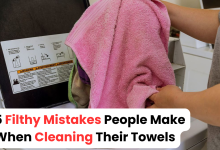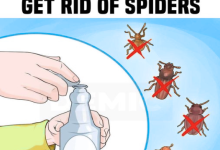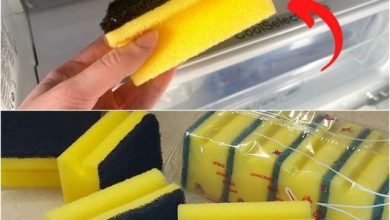Sure, we all know that we need to keep our smoke detectors in working order, and most of us would quickly deal with a problem like black mold growing on the wall. But what about the dangerous items in your home that you haven’t thought about? We’ve got a list of some of the most overlooked household hazards you should be aware of.
1. Ditch the Clutter, Especially on Stairs

Nearly half of all falling deaths occur on steps and stairways. Keeping the steps clutter-free seems obvious, but take a look at your own steps (especially those leading down to the basement). Who hasn’t set something on the top step “temporarily” with a plan to take it down on the next trip? It’s easy to use the steps as semipermanent storage, but it’s a very dangerous habit. Odds are that eventually, someone is going to trip over something and break an arm or leg (or neck).
2. Furniture Tipping

If you don’t think that furniture tipping over is a danger you have to worry about, learn of the numbers, and you’ll think twice when someone warns you of the dangers.
Every year, thousands of children are injured by furniture tipping over. Every two weeks, a child is killed by a tip-over. The stats, which come from the Consumer Reports (CR) and the Consumer Product Safety Commission, reveal there were 195 deaths caused by tip-overs between 2000 and 2016. CR also reported that in 2016, 2,800 incidents of injury to children from a falling piece of furniture occurred—a 33 percent spike from 2015.
Dresser tip-overs are the biggest culprit, with children pulling out dresser drawers to climb on them. Even the sturdiest dressers can fall forward.
3. Paper

It should go without saying that paper is a huge contributor to home fires but it’s the location of those papers that people don’t pay close enough attention to at home. Newspaper in the garage near the gas tank for the lawnmower is a common ignition source. See how to safely store gasoline.
Find a good, secret hiding place for your valuable papers in your home, well away from any ignition sources.
4. Overloaded Circuits

We’re so accustomed to turning our light switches and appliances on and off whenever we need them that sometimes we forget to respect the power of the electric currents that make such convenience possible. Overloaded surge protector power strips, extension cords, self-wired circuits, and poorly done DIY electrical repairs are just some of the homeowner-caused electrical hazards that may be lurking in your home. So before you plug in a power strip so you can run five items off one wall outlet, stop and think about the possible safety implications of your decision.
5. Grease on Stove Hood/Vent

Sometimes you’re so busy looking down at the pots and pans you’re using on your range or stovetop that you forget to glance up at the underside of the hood above your stove. Grease can accumulate quickly there and it takes just one flame or spark from a dish to cause a real problem. Any chef will tell you that grease fires are nothing to joke about. Be sure to follow manufacturer instructions and clean the vent and the area under your range hood regularly to cut down on this hazard!
6. Not Cooling Food Before Placing it in the Fridge

This is a big hazard. Wonder why your mayonnaise smelled off just a few days after you opened it? Surprised that your eggs only last a few days after purchase? Your problem may actually be the way you store leftover hot food. If you’re throwing a plastic container full of tonight’s straight from the stovetop and wedging in beside your cheese and eggs, you’re creating a very big food safety problem in your fridge. The heat from the hot food can heat up everything around it, seriously decreasing the lifespan of the perishables you keep in the fridge. Try cooling off your leftovers before you place them in their storage container by spreading them out in a large, shallow pain on your countertop for 10-20 minutes, stirring from time to time to speed up the cooling process. When the food has cooled to room temperature, then place it in a storage container and pop it in the fridge, but make sure it’s not touching any easily spoiled foods, even at room temperature.
7. Kitchen Sponge

We think of our kitchen sponges as clean items because we use them to clean things, but the truth is that they can be incredibly nasty little germ factories. When you use your kitchen sponge on your counters, dishes, appliances, and sink, you could be spreading bacteria like e.coli or salmonella all over your kitchen because you used that sponge to “clean” up after you were cooking.
8. Antibacterial Soap

This one may be counter-intuitive, but antibacterial soap can actually be a hazard. They are two main problems with the proliferation of antibacterial soap. The first is that the ingredient triclosan has been found by the FDA to affect hormone regulation in animals. Secondly, antibacterial soap kills bacteria indiscriminately, which means it kills both good and bad bacteria, and it is a suspect in the growing number of antibiotic-resistant superbugs.
9. Install Low-Pile Carpet

Thick carpet pile over a thick pad is the worst for anyone who is unstable walking—it increases the likelihood of tripping and falling. It also makes it more difficult to push and maneuver wheelchairs and walkers. To make getting around easier, consider installing a low-profile commercial-grade “level loop” or “cut pile” carpet with a pile height of no more than 1/2 in. and a 1/4-in. (10-lb. density) pad.
10. Loose Outlets

The constant movement of loose electrical outlets can loosen the wires connected to the outlet and create dangerous arcing.







